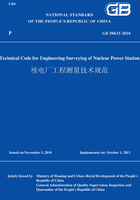
3.4 Triangulation
Ⅰ Main Technical Requirements for Triangulation
3.4.1 The main technical requirements for surveying triangulation networks of various accuracies shall be as specified in Table 3.4.1.
Table 3.4.1 Main technical requirements for triangulation

3.4.2 The angles of triangulation network should be totally observed,whereas the leg lengths can be totally or partially observed as required.Both the legs and angles as observed shall be used for adjustment calculations.
3.4.3 Two known azimuths should be referenced and transferred to determine the direction of primary control network.
Ⅱ Design,Point Selection,and Monumentation of Triangulation Network
3.4.4 Triangulation networks shall be arranged in accordance with the following requirements:
1 The triangles in primary control network should be arranged as approximately equilateral triangles as appropriate with each internal angle not less than 30°.Where topographic conditions are unfavorable,such internal angle may be permitted to be smaller in single cases,but in no case shall it be less than 25°.
2 The densified control networks may be arranged as inserting network,linear network,or independent points.
3 The vertices of triangles shall be determined in accordance with sub-clauses 1~4 of 3.3.5.
3.4.5 The monumentation and location diagrams of triangle vertices shall be as specified in Appendices B and C respectively.
Ⅲ Observation of Triangulation Network
3.4.6 The horizontal angles should be observed using direction method.
3.4.7 In addition to the requirement of 3.4.1,the observation of horizotal angles of trangulation network shall meet the requirements of 3.3.7,3.3.8,and 3.3.10 through 3.3.13.
3.4.8 In addition to the requirement of 3.4.1,the measurement of leg lengths of trangulation network shall meet the requirements of 3.3.14 through 3.3.19.
Ⅳ Triangulation Survey Data Processing
3.4.9 The angular RMSE of triangulation network shall be calculated using the following formula:

Where:
mβ——angular RMSE(second);
W——misclosure of triangle(second);
n——number of triangles.
3.4.10 The calculation of horizontal distances and accuracy assessment of the lengths of measured leg shall be as specified in 3.3.20 and 3.3.22 respectively.
3.4.11 Where Gauss projection is required,the observed bearings shall be reduced as follows for triangulation networks of fourth order and above:

Where:
δ1-2——reduced value of bearing observed from instrument station(Point 1)to target station(Point 2)(second);
δ2-1——reduced value of bearing observed from instrument station(Point 2)to target station(Point 1)(second);
x1,y1,x2,and y2——coordinates of Points 1 and 2(m);
Rm——mean curvature radius of reference ellipsoid at the midpoint of leg(m);
ρ——206265.
3.4.12 The reduction of the measured leg lengths to projection plane in triangulation network shall be as specified in 3.3.23.
3.4.13 When the field observations are completed,the various conditional misclosure of the triangulation network shall be calculated.The conditional misclosure shall not exceed the maximums which shall be calculated using the following formulas:
1 Maximum permitted angle-pole conditional misclosure:

Where:
Wj——maximum permitted angle-pole conditional misclosure;
mβ——angular RMSE required for the specific accuracy(second);
β——angle used for calculating distance;
ρ——206265".
2 Maximum permitted leg(baseline)conditional misclosure:

Where:
Wb——maximum permitted leg(baseline)conditional misclosure;
![]() and
and ![]() ——relative length RMSE of the starting leg.
——relative length RMSE of the starting leg.
3 Maximum permitted azimuth conditional misclosure:
Where:
Wf——maximum permitted azimuth conditional misclosure(second);
mα1 and mα2——RMSE of the starting azimuths(second);
n——estimated number of stations observed along the survey route.
4 Maximum permitted fixed angle conditional misclosure:
Where:
Wg——maximum permitted fixed angle conditional misclosure(second);
mg——RMSE of fixed angle(second).
5 Maximum permitted leg-angle conditional misclosure:

Where:
Wr——maximum permitted leg-angle conditional misclosure(second);
![]() ——average relative RMSE of the measured distances of various legs;
——average relative RMSE of the measured distances of various legs;
α and β——two angles other than the angle being observed;
mβ——angular RMSE required for the specific accuracy(second).
6 Maximum permitted leg-pole conditional misclosure:

Where:
Wz——maximum permitted leg-pole conditional misclosure(second);
αw——sum of the cotangents of both base angles opposite to polar point;
αf——sum of cotangents of the adjacent base angles at both sides of the radial leg which connects with the polar point of a polygon,sum of cotangents of the adjacent base angles at both sides of the inner radial leg of quadrangle,or difference between cotangents of the adjacent base angles of two external radial legs of quadrangle;
i——serial number of triangle.
3.4.14 For the purpose of adjustment of triangulation networks,the observed angles(or bearings)and leg lengths shall be used for adjustment.The prior angular and distance RMSE shall be calculated in accordance with 3.4.9 and 3.3.22 or may be otherwise estimated by the empirical formulas derived with mathematical statistics method,and then the weights of angles(or bearings)and leg lengths can be calculated with these prior RMSE.See 3.3.26 and 3.3.27 for adjustment method.